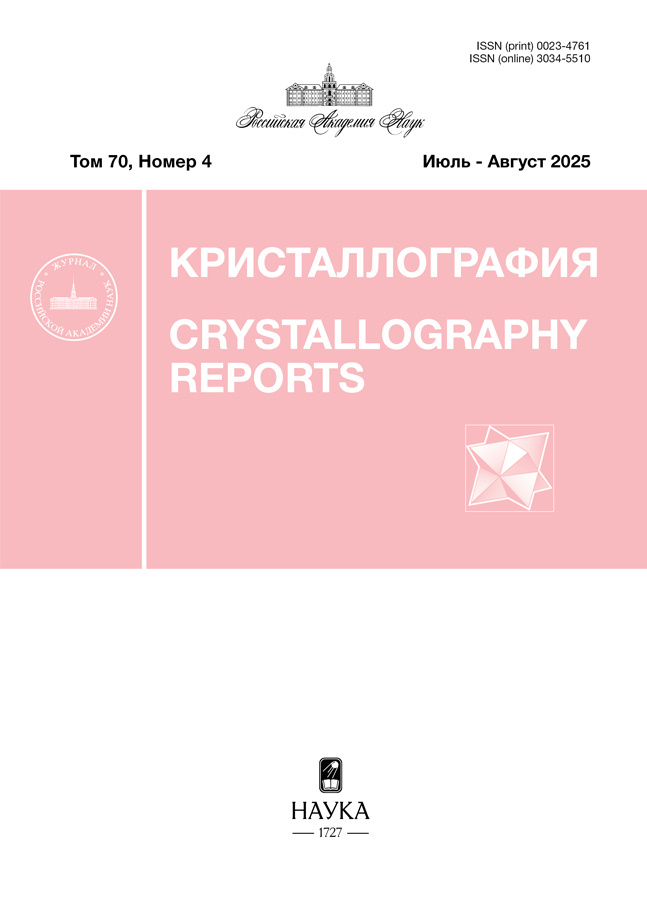Kinetics of discrete kinks and domain walls
- Autores: Petukhov B.V.1
-
Afiliações:
- National Research Center “Kurchatov Institute”
- Edição: Volume 70, Nº 4 (2025)
- Páginas: 583–589
- Seção: REAL STRUCTURE OF CRYSTALS
- URL: https://cardiosomatics.orscience.ru/0023-4761/article/view/688081
- DOI: https://doi.org/10.31857/S0023476125040063
- EDN: https://elibrary.ru/JFQFWS
- ID: 688081
Citar
Texto integral
Resumo
The kinetics of kinks and domain walls in quasi-one-dimensional systems is described within the framework of a model intermediate between the sharp kink model and the continuum model of an elastic string. The effects resulting from the discrete structure of crystalline materials are considered, including the periodic inhomogeneity of the energy relief for kink migration. Within the framework of a transparent approximation using a minimum number of internal variables, the dependence of the Peierls barriers on the driving force is calculated and the transition between static and dynamic regimes is described. The theory is based on the universal Frenkel-Kontorova model and can be applied to extended systems of various natures.
Texto integral
Sobre autores
B. Petukhov
National Research Center “Kurchatov Institute”
Autor responsável pela correspondência
Email: petukhov@crys.ras.ru
Shubnikov Institute of Crystallography of the Kurchatov Complex Crystallography and Photonics
Rússia, MoscowBibliografia
- One-Dimensional Nanostructures / Ed. Wang Z.M. N.Y.: Springer, Science+Business Media, 2008. 329 p.
- Давыдов А.С. // Успехи физ. наук. 1982. Т. 138. С. 603.
- Remoissenet M. Waves Called Solitons. Concepts and Experiments. Berlin: Springer, 1994. 335 p.
- Nonlinear Science at the Dawn of the 21st Century / Eds. Christiansen P.L. et al. Springer Science and Business Media, 2000. V. 542. 457 p.
- Хирт Дж., Лоте И. Теория дислокаций. М.: Атом-издат, 1972. 598 с.
- Messerschmidt U. Dislocation dynamics during plastic deformation / Ed. Hull R. Berlin; Heidelberg: Springer Science and Business Media, 2010. 503 p.
- Indenbom V.L., Petukhov B.V., Lothe J. // Modern Problems in Condensed Matter Sciences. Elsevier, 1992. V. 31. P. 489.
- Петухов Б.В. Динамика дислокаций в кристаллическом рельефе. Дислокационные кинки и пластичность кристаллических материалов. Saarbrucken: Lambert Academic Publishing, 2016. 385 с. EDN UVWRYG
- Додд Р., Эйлбек Дж., Гиббон Дж., Моррис. Солитоны и нелинейные волновые уравнения. М.: Мир, 1988. 694 с.
- Kivshar Y.S., Malomed B.A. // Rev. Mod. Phys. 1989. V. 61. P. 763. https://doi.org/10.1103/RevModPhys.61.763
- Bishop A.R., Krumhansl J.A., Trullinger S.E. // Physica D: Nonlinear Phenomena. 1980. V. 1. P. 1. https://doi.org/10.1016/0167-2789(80)90003-2
- Scott A. Nonlinear science: emergence and dynamics of coherent structures. Oxford: Oxford University Press, 2003. 504 p.
- Vachaspati T. Kinks and Domain Walls. An Introduction to Classical and Quantum Solitons. Cambridge University Press. Cambridge, N.Y. Melbourne, Madrid, Cape Town, Singapore, S˜ao Paulo. 2006. 176 p.
- Cuevas-Maraver J., Kevrekidis P.G., Williams F. The sine-Gordon model and its applications. From Pendula and Josephson Junctions to Gravity and High-Energy Physics. Nonlinear Systems and Complexity. Switzerland: Springer, 2014. 263 p. https://doi.org/10.1007/978-3-319-06722-3
- Захаров В.Е., Манаков С.В., Новиков С.П., Питаевский Л.П. Теория солитонов: Метод обратной задачи. М.: Наука, 1980. 319 с.
- Clerc M.G., Elías R.G., Rojas R.G. // Philos. Trans. Roy. Soc. A. 2011. V. 369. P. 1. https://doi.org/10.1098/rsta.2010.0255
- Ablowitz M.J., Musslimani Z.H., Biondini G. // Phys. Rev. E. 2002. V. 65. 026602. https://doi.org/10.1103/PhysRevE.65.026602
- Hennig D., Tsironis G.P. // Phys. Rep. 1999. V. 307. № 5–6. P. 333. https://doi.org/10.1016/S0370-1573(98)00025-8
- Peyrard M., Kruscal M.D. // Physica D: Nonlinear Phenomena. 1984. V. 14. P. 88. https://doi.org/10.1016/0167-2789(84)90006-X
- Schaumburg H. // Philos. Mag. 1972. V. 25. P. 1429.
- Никитенко В.И., Фарбер Б.Я., Иунин Ю.Л. // ЖЭТФ. 1987. Т. 93. С. 1304.
- Iunin Yu.L., Nikitenko V.I. // Scr. Mater. 2001. V. 45. P. 1239. https://doi.org/10.1016/S1359-6462(01)01156-3
- Yonenaga I. // Mater. Trans. 2005. V. 46. P. 1979. https://doi.org/10.2320/matertrans.46.1979
- Claeys C., Simoen E. Extended Defects in Germanium. Springer Series in Materials Science. V. 118. Berlin; Heidelberg: Springer, 2009. 207 p. https://doi.org/10.1007/978-3-540-85614-6_1
- Инденбом В.Л. // Кристаллография. 1958. Т. 3. С. 197.
- Combs J.A., Yip S. // Phys. Rev. B. 1983. V. 28. P. 6873. https://doi.org/10.1103/PhysRevB.28.6873
- Flach S., Kladko K. // Phys. Rev. E. 1996. V. 54. P. 2912. https://doi.org/10.1103/PhysRevE.54.2912
- Carpio A., Bonilla L.L. // Phys. Rev. Lett. 2001. V. 86. P. 6034. https://doi.org/10.1103/PhysRevLett.86.6034
- Усатенко О.В., Горбач А.В., Ковалев А.С. // ФТТ. 2001. Т. 43. С. 1202.
- Петухов Б.В. // ФТТ. 2025. Т. 67. С. 382. https://doi.org/10.61011/FTT.202502.59996.261
- Dirr N., Yip N.K. // Interfaces and Free Boundaries. 2006. V. 8. P. 79.
- Yakushevich L.V., Krasnobaeva L.A. // Biophys. Rev. 2021. V. 13. P. 315. https://doi.org/10.1007/s12551-021-00801-0
- Martinez-Pedrero F., Tierno P., Johansen T.H., Straube A.V. // Sci. Rep. 2016. V. 6. P. 19932. https://doi.org/10.1038/srep19932
- Нацик В.Д., Смирнов С.Н. // Кристаллография. 2009. Т. 54. С. 1034.
- Браун О.М., Кившарь Ю.С. Модель Френкеля–Конторовой. Концепции, методы и приложения. М: ФИЗМАТЛИТ, 2008. 322 с.
- Kratohvil J., Indenbom V.L. // Czech. J. Phys. 1963. V. 13. P. 814. https://doi.org/10.1007/BF01688006
- Kladko K., Mitkov I., Bishop A.R. // Phys. Rev. Lett. 2000. V. 84. P. 4505. https://doi.org/10.1103/PhysRevLett.84.4505
- Mitkov I., Kladko K., Bishop A.R. // Phys. Rev. E. 2000. V. 61. P. 1106. https://doi.org/10.1103/PhysRevE.61.1106
- deCastroM., Hofer E., Munuzuri M. // Phys. Rev. E. 1999. V. 59. P. 5962. https://doi.org/10.1103/PhysRevE.59.5962
Arquivos suplementares















